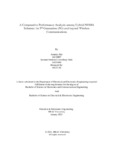| dc.contributor.advisor | Chowdhury, Arshad M. | |
| dc.contributor.advisor | Haider, Majumder Fazle | |
| dc.contributor.author | Bal, Anindya | |
| dc.contributor.author | Nuhi, Jannatul Ferdous Chowdhury | |
| dc.contributor.author | Sur, Mousumi | |
| dc.date.accessioned | 2021-08-02T06:17:33Z | |
| dc.date.available | 2021-08-02T06:17:33Z | |
| dc.date.copyright | 2021 | |
| dc.date.issued | 2021-01 | |
| dc.identifier.other | ID: 16110007 | |
| dc.identifier.other | ID: 16221040 | |
| dc.identifier.other | ID: 16121142 | |
| dc.identifier.uri | http://hdl.handle.net/10361/14902 | |
| dc.description | This thesis is submitted in partial fulfillment of the requirements for the degree of Bachelor of Science in Electrical and Electronic Engineering, 2021. | en_US |
| dc.description | Cataloged from PDF version of thesis. | |
| dc.description | Includes bibliographical references (pages 65-75). | |
| dc.description.abstract | A full-scale implementation of 5G and beyond wireless communication systems require more
effective radio access techniques. To address this issue non-orthogonal multiple access
(NOMA) technique is considered as a most promising technology in recent times. NOMA is
superior in terms of spectral efficiency and user density than the existing orthogonal multiple
access (OMA) technique utilizing the limited resources, though NOMA allows controllable
interferences by non-orthogonal resource allocation. Successive Interference Cancellation
(SIC) can efficiently mitigate the impact of interference when implemented massively, but it
raises computational complexity significantly, hence, reduces energy efficiency. In order to
alleviate the drawbacks of NOMA, hybrid NOMA schemes have been proposed in recent
research works. This thesis work focuses on comparative performance analysis among hybrid
NOMA schemes such as MIMO-NOMA, NOMA-GSSK and STBC-CNOMA. The purpose of
the work is also to recommend the best suited hybrid scheme for next generation wireless
networks. Numerical analysis and simulation results validate the superiority of the NOMAGSSK scheme in terms of bit error probability and spectral efficiency than other two promising
schemes. The findings also suggest that STBC-CNOMA certainly outweighs other two
schemes considering system complexity and energy efficiency. | en_US |
| dc.description.statementofresponsibility | Anindya Bal | |
| dc.description.statementofresponsibility | Jannatul Ferdous Chowdhury Nuhi | |
| dc.description.statementofresponsibility | Mousumi Sur | |
| dc.format.extent | 75 Pages | |
| dc.language.iso | en_US | en_US |
| dc.publisher | Brac University | en_US |
| dc.rights | Brac University theses are protected by copyright. They may be viewed from this source for any purpose, but reproduction or distribution in any format is prohibited without written permission. | |
| dc.subject | NOMA | en_US |
| dc.subject | MIMO-NOMA | en_US |
| dc.subject | NOMA-GSSK | en_US |
| dc.subject | STBC-CNOMA | en_US |
| dc.subject | BEP | en_US |
| dc.subject | Energy Efficiency | en_US |
| dc.subject | Spectral Efficiency | en_US |
| dc.subject | SIC. | en_US |
| dc.subject | Wireless communication systems | en_US |
| dc.subject | 5G | en_US |
| dc.title | A comparative performance analysis among Hybrid NOMA Schemes for 5th Generation (5G) and beyond Wireless Communications | en_US |
| dc.type | Thesis | en_US |
| dc.contributor.department | Department of Electrical and Electronic Engineering, Brac University | |
| dc.description.degree | B. Electrical and Electronic Engineering | |

